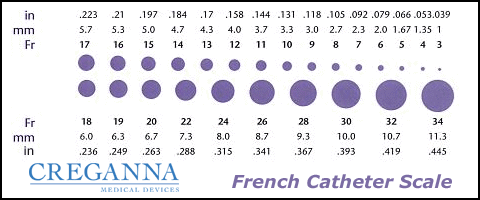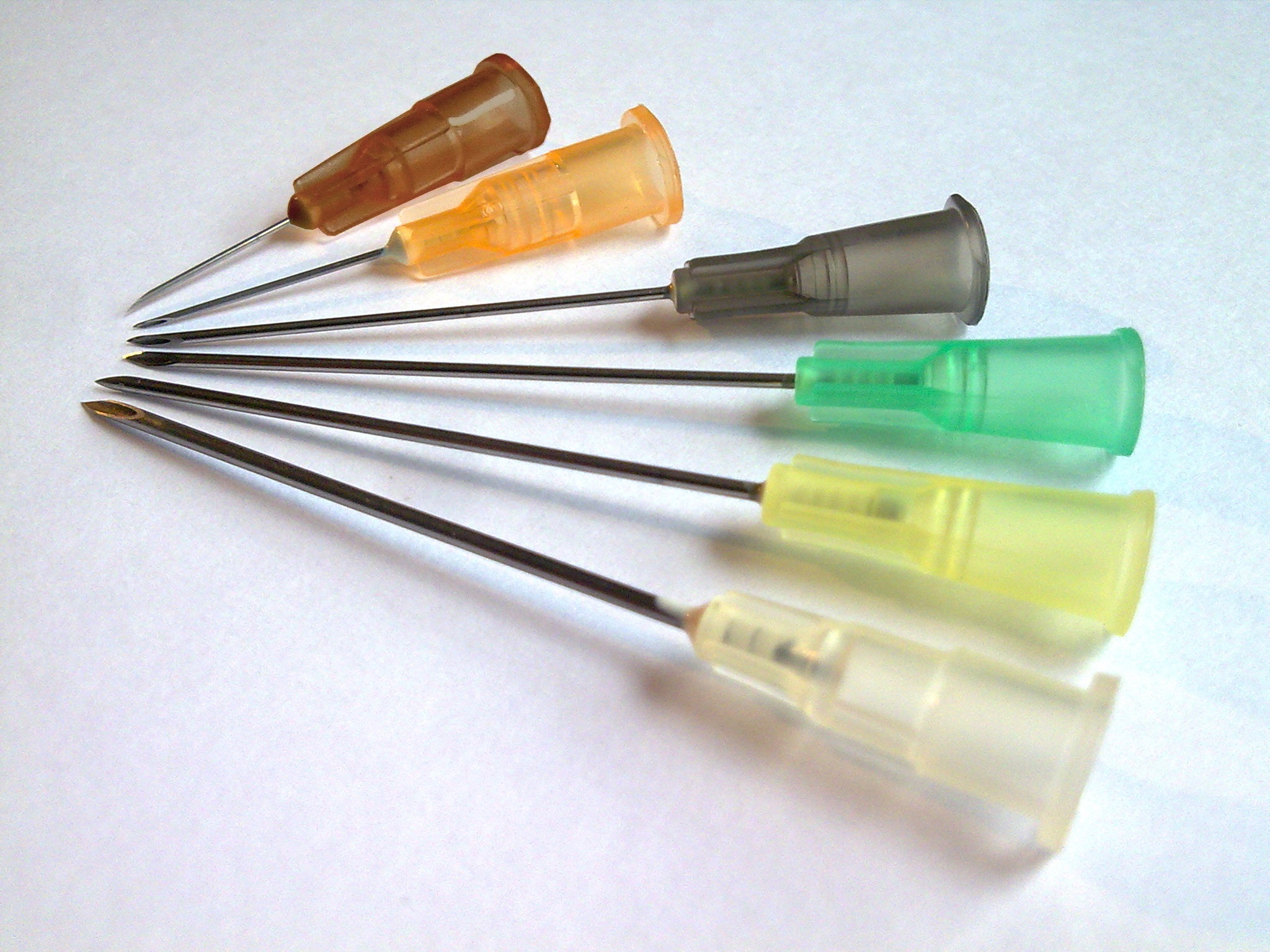|
French (catheter Scale)
The French scale, also known as the French gauge or Charrière system, is a widely used measurement system for the size of catheters. It is commonly abbreviated as Fr but may also be abbreviated as Fg, FR or F, and less frequently as CH or Ch (referencing its inventor, Charrière). However, the term ''gauge'', abbreviated ''G'' or ''ga'', typically refers to the Birmingham gauge for hypodermic needles. The French scale measures and is proportional to the outer diameter of a catheter, with 1 French (Fr) defined as millimeter, making the relationship: 1 mm = 3 Fr. Thus, the outer diameter of a catheter in millimeters can be calculated by dividing the French size by 3. For example, a catheter with a French size of 9 would have an outer diameter of approximately 3mm. While the French scale aligns closely with the metric system, it introduces redundancy and the potential for rounding errors. This metrication problem is further complicated in medical contexts where metric and im ... [...More Info...] [...Related Items...] OR: [Wikipedia] [Google] [Baidu] |
Catheter
In medicine, a catheter ( ) is a thin tubing (material), tube made from medical grade materials serving a broad range of functions. Catheters are medical devices that can be inserted in the body to treat diseases or perform a surgical procedure. Catheters are manufactured for specific applications, such as cardiovascular, urological, gastrointestinal, neurovascular and ophthalmic procedures. The process of inserting a catheter is called ''catheterization''. In most uses, a catheter is a thin, flexible tube (''soft'' catheter) though catheters are available in varying levels of stiffness depending on the application. A catheter left inside the body, either temporarily or permanently, may be referred to as an "indwelling catheter" (for example, a peripherally inserted central catheter). A permanently inserted catheter may be referred to as a "permcath" (originally a trademark). Catheters can be inserted into a body cavity, duct, or vessel, brain, skin or adipose tissue. Functional ... [...More Info...] [...Related Items...] OR: [Wikipedia] [Google] [Baidu] |
Joseph-Frédéric-Benoît Charrière
Joseph-Frédéric-Benoît Charrière (March 19, 1803 – April 28, 1876) was a Swiss-born French manufacturer of surgical instruments. Charrière was born in Cerniat, in the Canton of Fribourg, Switzerland. He moved to Paris at age 13, and was apprenticed to a manufacturer of knives. In 1820, he founded a company manufacturing surgical instruments, which quickly grew to 400 employees by around 1840, and was world-famous by his death. He became a naturalized French citizen in 1843. He developed and improved a number of instruments, especially hypodermic needles and catheters; the French catheter scale is named after his work. In order to achieve this, Charrière benefitted from at the time newly developed materials such as nickel silver, stainless steel, and rubber. Several of his apprentices also became well-known instrument makers, including Georges-Guillaume-Amatus Lüer, Louis-Joseph Mathieu, and Adolphe Collin in Paris; Josef Leiter in Vienna; and Camillus Nyrop in C ... [...More Info...] [...Related Items...] OR: [Wikipedia] [Google] [Baidu] |
Birmingham Gauge
The Birmingham gauge, officially the Birmingham Wire Gauge and often abbreviated as ''G'' or ''ga'', is unit or wire gauge used to measure the thickness or diameter of wires and tubing, including hypodermic needles and other medical tube products. Terminology The Birmingham gauge is also known as the Stubs Iron Wire Gauge or Birmingham Wire Gauge and is distinct from the Stubs Steel Wire Gauge and the British Standard Wire Gauge. It is commonly referred to simply as ''gauge'' (abbreviated as ''G''), but this should not be confused with the French gauge, a separate system used for measuring the outer diameter of catheters. System The Birmingham gauge ranges from 5/0 or 00000, the lowest gauge number corresponding to the largest size of , to 36, the highest gauge number corresponding to the smallest size of . The increments between gauge sizes are not linear and vary. At higher gauge numbers, the increment between the two highest gauges is , while at lower gauge numbers, the ... [...More Info...] [...Related Items...] OR: [Wikipedia] [Google] [Baidu] |
Metric System
The metric system is a system of measurement that standardization, standardizes a set of base units and a nomenclature for describing relatively large and small quantities via decimal-based multiplicative unit prefixes. Though the rules governing the metric system have changed over time, the modern definition, the International System of Units (SI), defines the metric prefixes and seven base units: metre (m), kilogram (kg), second (s), ampere (A), kelvin (K), Mole (unit), mole (mol), and candela (cd). An SI derived unit is a named combination of base units such as hertz (cycles per second), Newton (unit), newton (kg⋅m/s2), and tesla (unit), tesla (1 kg⋅s−2⋅A−1) and in the case of Celsius a shifted scale from Kelvin. Certain units have been Non-SI units mentioned in the SI#Units officially accepted for use with the SI, officially accepted for use with the SI. Some of these are decimalised, like the litre and electronvolt, and are considered "metric". Others, like ... [...More Info...] [...Related Items...] OR: [Wikipedia] [Google] [Baidu] |
Rounding Errors
In computing, a roundoff error, also called rounding error, is the difference between the result produced by a given algorithm using exact arithmetic and the result produced by the same algorithm using finite-precision, rounded arithmetic. Rounding errors are due to inexactness in the representation of real numbers and the arithmetic operations done with them. This is a form of quantization error. When using approximation equations or algorithms, especially when using finitely many digits to represent real numbers (which in theory have infinitely many digits), one of the goals of numerical analysis Numerical analysis is the study of algorithms that use numerical approximation (as opposed to symbolic computation, symbolic manipulations) for the problems of mathematical analysis (as distinguished from discrete mathematics). It is the study of ... is to estimate computation errors. Computation errors, also called numerical errors, include both truncation errors and roundo ... [...More Info...] [...Related Items...] OR: [Wikipedia] [Google] [Baidu] |
Metrication
Metrication or metrification is the act or process of converting to the metric system of measurement. All over the world, countries have transitioned from local and traditional Unit of measurement, units of measurement to the metric system. This process began in French Revolution, France during the 1790s, and has persistently advanced over two centuries, accumulating into 95% of the world officially only using the International System of Units, modern metric system. Nonetheless, this also highlights that certain countries and sectors are either still transitioning or have chosen not to fully adopt the metric system. Overview The process of metrication is typically initiated and overseen by a country's government, generally motivated by the necessity of establishing a uniform measurement system for effective international cooperation in fields like trade and science. Governments achieve metrication through either mandatory changes to existing units within a specified timeframe ... [...More Info...] [...Related Items...] OR: [Wikipedia] [Google] [Baidu] |
Imperial Units
The imperial system of units, imperial system or imperial units (also known as British Imperial or Exchequer Standards of 1826) is the system of units first defined in the British Weights and Measures Act 1824 and continued to be developed through a series of Weights and Measures Acts and amendments. The imperial system developed from earlier English units as did the Comparison of the imperial and US customary measurement systems, related but differing system of United States customary units, customary units of the United States. The imperial units replaced the Winchester measure, Winchester Standards, which were in effect from 1588 to 1825. The system came into official use across the British Empire in 1826. By the late 20th century, most nations of the former empire had metrication, officially adopted the metric system as their main system of measurement, but imperial units are still used alongside metric units in the United Kingdom and in some other parts of the former empi ... [...More Info...] [...Related Items...] OR: [Wikipedia] [Google] [Baidu] |
French Catheter Scale
The French scale, also known as the French gauge or Charrière system, is a widely used measurement system for the size of catheters. It is commonly abbreviated as Fr but may also be abbreviated as Fg, FR or F, and less frequently as CH or Ch (referencing its inventor, Charrière). However, the term ''gauge'', abbreviated ''G'' or ''ga'', typically refers to the Birmingham gauge for hypodermic needles. The French scale measures and is proportional to the outer diameter of a catheter, with 1 French (Fr) defined as millimeter, making the relationship: 1 mm = 3 Fr. Thus, the outer diameter of a catheter in millimeters can be calculated by dividing the French size by 3. For example, a catheter with a French size of 9 would have an outer diameter of approximately 3mm. While the French scale aligns closely with the metric system, it introduces redundancy and the potential for rounding errors. This metrication problem is further complicated in medical contexts where metric and im ... [...More Info...] [...Related Items...] OR: [Wikipedia] [Google] [Baidu] |
Catheters
In medicine, a catheter ( ) is a thin tube made from medical grade materials serving a broad range of functions. Catheters are medical devices that can be inserted in the body to treat diseases or perform a surgical procedure. Catheters are manufactured for specific applications, such as cardiovascular, urological, gastrointestinal, neurovascular and ophthalmic procedures. The process of inserting a catheter is called ''catheterization''. In most uses, a catheter is a thin, flexible tube (''soft'' catheter) though catheters are available in varying levels of stiffness depending on the application. A catheter left inside the body, either temporarily or permanently, may be referred to as an "indwelling catheter" (for example, a peripherally inserted central catheter). A permanently inserted catheter may be referred to as a "permcath" (originally a trademark). Catheters can be inserted into a body cavity, duct, or vessel, brain, skin or adipose tissue. Functionally, they allow dr ... [...More Info...] [...Related Items...] OR: [Wikipedia] [Google] [Baidu] |




